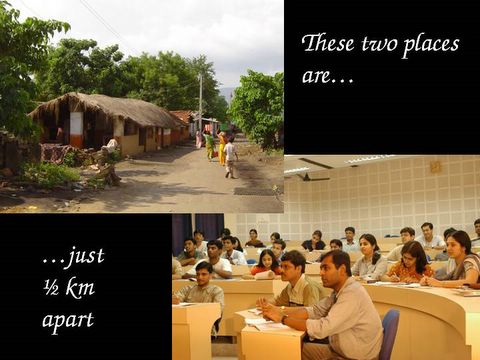First the Good News:
Yesterday, Montek Singh Ahluwalia, the Dy Chairman of Planning Commission, told the audience of Sardar Patel Memorial Lecture (organised by All India Radio) that at the present rate of growth (8%), India could well become the world's 3rd largest economic power by 2020.
Even better news was that by 2020 India will be able to eradicate poverty completely. He cited figures as to how the population "living" (to use a term, in the absense of a more apprpriate one) below poverty line has been decreasing - from 56% in 1973-74 to 39% (1987-88) to 37% (1993-94) to as low as 26% in 1999-2000... At the present rate of 1.6%/annum reduction in poor population, it will just take another 15 years to achieve this feat!!!
[one can almost imagine the thunderous applause at these pronouncements... After all he is an economist - not a politician who are given to rhetorics - and is quoting facts and figures]
...as if to vindicate his claim, earlier this month, the Sensex had broken through the 8000 magical number, and FDIs grew by 25% last year, and Indian exports are growing rapidly!!!
...and now the Slightly Not-So-Good News Analysis:
How does India define its poor? How do we calculate the "poverty line"?
To go back in the history, the first official announcement of poverty-line was made in 1978, during Morarji Desai's government. The calculation for poverty line was - and remains - simple: how much nutrition would a person need to stay alive?
According to Govt of India, a person requires 2,400 calories in rural areas, and 2,100 calories in the urban area. The money needed to buy grains worth that much calories is the Poverty Line.
In the 1970s, it used to be Rs 61.80/person/month for rural areas and Rs 71.30 for urban areas. Adjusting to inflation, now it has gone up to Rs 328 in rural areas and Rs 454 in urban areas (Congratulations!!, if you earn more than Rs 500/month in India, you are not among the poverty stricken masses!)
Notwithstanding the fact that (1) a healthy nourishment also includes protein, vitamins, minerals, etc., which are not factored in to calculate the poverty line, and (2) according to the the National Institute of Nutrition (part of Indian Council of Medical Research), Indians require more calories to survive (2,900 calories in rural, and 2,400 calories in urban India), there is something perplexing - and perverted - about this definition!
Essentially, it defines someone as "not poor" who is not starving to death!!!...
...that is: even if
But as long as I am not dying of hunger, I am "not poor"!!!
An article by the Center for Policy Alternatives, New Delhi, makes some revealing calculations to correct this anamoly.
Imagine, the bare minimum needs of a "not poor" person: S/he lives in a family of five person (husband-wife, three children of 5, 10, and 15 age). Minimum nutrition. A small house (two rooms of 10'x10'). A bulb and fan in the rooms. A running tap in kitchen and bathroom. Clothes. Primary education for kids in the government-run subsidized schools. Basic healthcare.
If one defines "poor" as someone not having this bare minimum, then the Indian "poverty line" needs to be set at Rs 1580/month/person!!... Or around Rs 7,900/month for a family of 5.
And given the recent National Sample Survey data (i.e., 93% of Rural India spends less than Rs 950/person, and 83% of Urban India spends less than Rs 1500/person), apparently, more than 90% of Indians do not meet the above minimum definition of "not poor" - and are poor!!!
But then, these are the inhabitants of the Invisible India...
Sources:
India Could Become Third Largest Economy
Tripping over the Poverty Line
Living in Two India(s)






